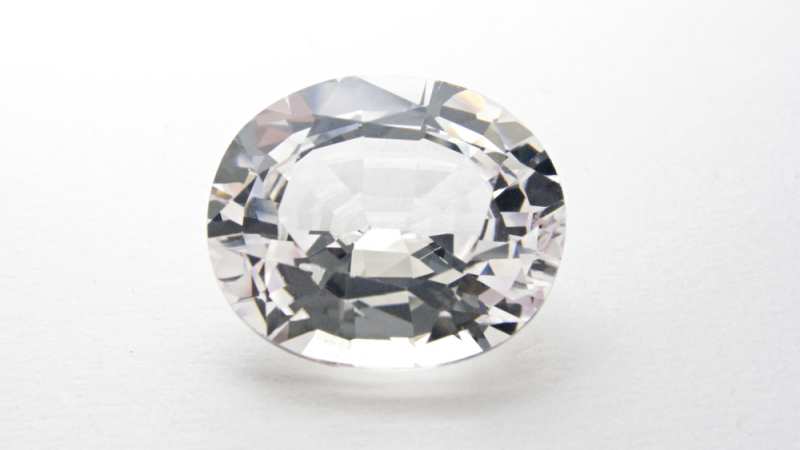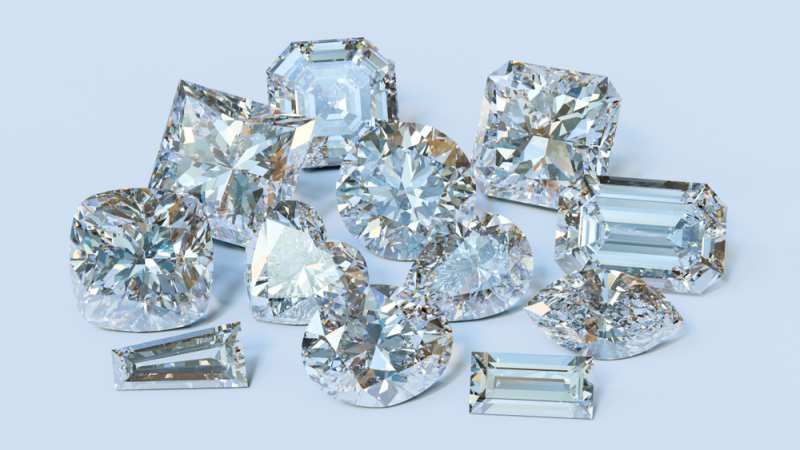The cost of diamonds is well-known, making them unaffordable for many people. As a result, when searching for a ring with a diamond-like gemstone, you may encounter alternatives such as moissanite, cubic zirconia, and white sapphire.
Now, the question arises: Moissanite vs. cubic zirconia vs. white sapphire – which one should you choose for your ring?
These three options serve as alternatives to diamonds, offering a significantly lower price point. Each alternative possesses distinct characteristics, which we will explore in detail.
Without delay, let’s delve into the world of diamond alternatives!
DESIGN YOUR OWN ENGAGEMENT RING: START WITH A SETTING OR START WITH A DIAMOND. IT’S REALLY UP TO YOU!

What Is Moissanite?
Moissanite, a near-colorless stone composed of silicon carbide, was first discovered by French scientist Henri Moissan in a meteor-created crater. Although moissanite resembles diamonds in appearance, it differs in composition and origin. While diamonds are carbon-based, moissanite is a natural mineral composed of pure silicon carbide.
Naturally-occurring moissanite is extremely rare, making it impractical for jewelry. Therefore, the moissanite available in the market today is lab-created. Despite its diamond-like appearance, moissanite has distinct characteristics.
Moissanite: Color
When compared closely, moissanite and diamonds exhibit noticeable differences in color. While diamonds are graded on a color scale, moissanite does not have a standardized color grading system. Instead, moissanite resembles the color grade of K in diamonds. Under certain lighting conditions, moissanite may exhibit yellow, green, or gray tints, especially in larger gemstones.
Moissanite: Clarity
Similar to diamonds, moissanite can have inclusions and blemishes that affect its clarity. Although moissanite is not graded by impartial gemological labs like GIA or AGS, manufacturers or sellers may provide a clarity grade. Most lab-created moissanite on the market has clarity levels comparable to the VS range and is often close to flawless.
Moissanite: Cut
Moissanite is available in various shapes, including round, pear, oval, cushion, radiant, and princess cuts. The round brilliant cut is particularly popular due to its exceptional brilliance and ability to minimize color. It is versatile and suitable for both modern and vintage-style jewelry.
Moissanite: Hardness
On the Mohs scale of mineral hardness, moissanite scores 9.25 out of 10. Although it is not as hard as diamonds, moissanite is still highly durable and can only be scratched by minerals of equal or greater hardness, such as diamonds.
Moissanite: Value
The value of diamonds is determined by various factors, leading to significant price variations. In contrast, moissanite generally maintains a consistent price, unless differences arise due to material type (enhanced or unenhanced) or size.
Here is a chart illustrating the price difference between diamonds and moissanite:
[Chart comparing diamond prices and moissanite prices]
| Size In Carats | Diamond Price | Size In Millimeters (the closest equivalent to carats) | Moissanite Price |
|---|---|---|---|
| 0.50 | $1050 | 5 | $510 |
| 0.75 | $2200 | 6 | $680 |
| 1.00 | $3880 | 6.5 | $850 |

What Is Cubic Zirconia?
Cubic zirconia, a synthetic gemstone composed of cubic crystalline zirconium dioxide, can rarely occur naturally but is predominantly lab-created in today’s jewelry market.
Considered a low-cost alternative to diamonds, cubic zirconia possesses unique aesthetic qualities and a distinct physical structure due to its synthetic nature. The manufacturing process involves melting zirconium oxide powder with magnesium and calcium, resulting in the formation and stabilization of cubic zirconia crystals, which are then cut and polished similar to diamonds. It’s important to note that different laboratories may employ their own specific methods for producing cubic zirconia.
Cubic Zirconia: Beauty and Brilliance
Cubic zirconia lacks the true brilliance of diamonds and possesses a lower refractive index, ranging between 2.15 and 2.18 compared to 2.42 for diamonds. Light interacts with cubic zirconia differently, resulting in significantly less reflection than diamonds. This disparity in light reflection becomes apparent when comparing the two under appropriate lighting conditions. Overall, cubic zirconia cannot match the beauty and brilliance of diamonds.
Cubic Zirconia: Color and Clarity
Since cubic zirconia is lab-created, it lacks the natural inclusions and blemishes typically found in diamonds, leading to high clarity. However, some people perceive cubic zirconia as “too perfect” or artificial due to its flawless appearance. Although considered colorless due to its manufactured nature, lab-created cubic zirconia often exhibits an orange-tinted light, serving as a clear indicator of its synthetic origin.
Cubic Zirconia: Durability and Density
While diamonds rank a perfect 10 on the Mohs scale of hardness, cubic zirconia falls at 8.5. Despite its synthetic composition, cubic zirconia offers reasonable durability and can be set and worn in jewelry. However, it cannot match the longevity of diamonds. Additionally, cubic zirconia is slightly denser than diamonds, allowing gemologists or jewelers to differentiate between the two by weighing them on a scale.
Cubic Zirconia: Value
From a value standpoint, cubic zirconia holds little worth. While the setting of a cubic zirconia ring may retain some value if resold, the gemstone itself carries no market value. Retail prices for rings featuring cubic zirconia gems typically range between $15 and $25, providing a clear distinction in value compared to diamonds.

What Is White Sapphire?
While sapphires are commonly associated with the color blue, they naturally occur in various hues, including white.
As members of the corundum mineral family, sapphires are composed of aluminum oxide with traces of iron, copper, titanium, and chromium. The presence of these minerals determines the gemstone’s color.
White sapphires are often used as substitutes for diamonds due to their colorless appearance and lower price tag.
In terms of cut and color, a white sapphire ring resembles a diamond ring with some minor differences.
Generally, white sapphires are less expensive than diamonds and often appear as gray or yellow stones that have been treated with heat or chemicals to achieve their clear color.
While natural white sapphires do exist, they are extremely rare. Therefore, two main types of white sapphires are commonly used in jewelry: natural white sapphires and lab-created white sapphires.
White Sapphires: Cut
Various cutting styles are employed for colored gemstones. However, there is no standardized grading scale for different cutting styles and gemstones.
Nonetheless, white sapphires are available in a wide range of shapes, similar to diamonds.
White Sapphire: Color
Color is a crucial factor when selecting colored gemstones. With white sapphires, a purer colorlessness is generally preferred.
Interestingly, brilliance is less significant in white sapphires compared to diamonds.
Assessing the color of a sapphire should rely on personal preference and the naked eye. Watch out for color-zoning, and a more consistent color throughout the gemstone is typically more valuable. White sapphires often undergo color treatments to enhance their appearance, making them more affordable than natural white sapphires. These treatments can involve chemicals or heat, depending on the stone’s structure and the desired effect.
White Sapphires: Clarity
Colored gemstones tend to have more internal imperfections than diamonds, but these imperfections are typically only visible under 10x magnification.
To evaluate the clarity of a white sapphire, closely examine the gemstone and determine if there are any inclusions or blemishes that may affect its overall beauty.
White Sapphires: Hardness
White sapphires rank 9 on the Mohs scale of mineral hardness, making them more durable than moissanite and cubic zirconia but not as durable as diamonds.
White Sapphire: Value
White sapphires serve as a more affordable alternative to diamonds.
However, it’s important to note that white sapphires do not possess the same level of brilliance as diamonds.
With larger white sapphires, it becomes more noticeable that they are not genuine diamonds. Due to their lack of brilliance, larger white sapphires may appear lifeless.
To provide a clearer comparison, a 1-carat white sapphire generally costs around $830, significantly less than a diamond of the same carat weight.

Bottom Line
So, when it comes to choosing between moissanite, cubic zirconia, and white sapphire, it depends on your preferences and priorities.
If you’re looking for the most affordable option, cubic zirconia is the way to go. However, it may lack the value and natural characteristics of the other gemstones since it is lab-made and often appears “too perfect.”
Moissanite, while not naturally occurring, offers a good balance between price and beauty. It can closely resemble a diamond and provides a nice alternative at a more reasonable cost.
White sapphire can provide a more natural appearance but sacrifices some brilliance along the way. It offers a compromise between cost and a diamond-like appearance.
It’s important to note that none of these gemstones can match the inherent beauty of a diamond. However, if your goal is to have a gemstone that closely resembles a diamond at a significantly lower price, any of these three options would be suitable. Ultimately, the choice depends on your budget and personal preferences.


